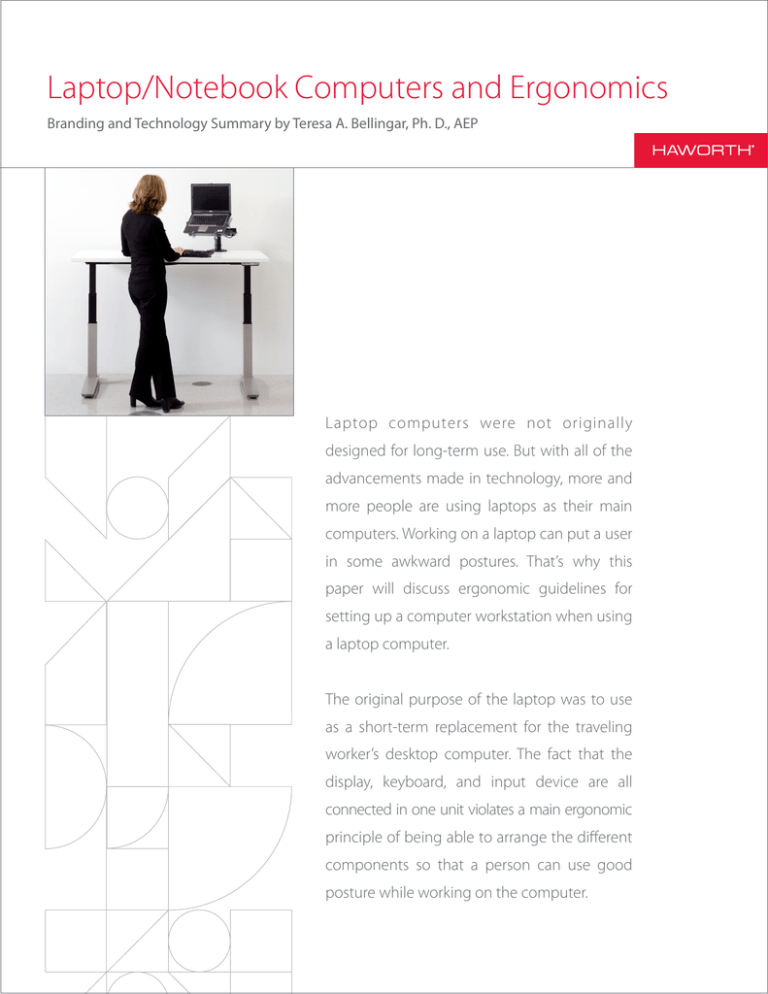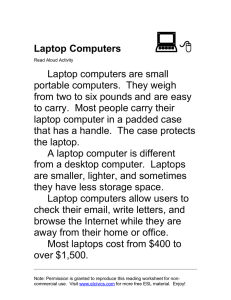Laptop/Notebook Computers and Ergonomics
advertisement

Laptop/Notebook Computers and Ergonomics Branding and Technology Summary by Teresa A. Bellingar, Ph. D., AEP Laptop computers were not originally designed for long-term use. But with all of the advancements made in technology, more and more people are using laptops as their main computers. Working on a laptop can put a user in some awkward postures. That’s why this paper will discuss ergonomic guidelines for setting up a computer workstation when using a laptop computer. The original purpose of the laptop was to use as a short-term replacement for the traveling worker’s desktop computer. The fact that the display, keyboard, and input device are all connected in one unit violates a main ergonomic principle of being able to arrange the different components so that a person can use good posture while working on the computer. Laptop/Notebook Computers and Ergonomics / 10.11 Basically, since the keyboard and the monitor are attached to each other, if the keyboard is in the correct position for the user, the screen is not. If the screen is in the correct position, the keyboard is not. Additionally, keyboards on laptops can be 25 percent smaller than standard-size keyboards, causing some individuals to work with awkward hand and wrist postures. Laptops allow flexibility to work from a variety of locations, however, it also means that more and more people can be found hunched over their laptops working in poor postures. When working on a laptop computer, you should always try and follow the guidelines for ergonomically setting up a computer workstation. Some advanced laptop and notebook computers have detachable screens, allowing the independent adjustment of both the monitor and the keyboard making it very similar to a desktop computer. Below are some guidelines to follow to help users achieve greater comfort using a traditional laptop computer. Short-Term Users • A trade-off will most likely need to be made between poor neck and head posture or poor hand and wrist posture. Being that the neck/head position is controlled by a larger muscle group, it is often better to have good hand/wrist posture than neck/ head posture. • It’s important to sit in as comfortable a chair as possible. • The laptop should be positioned so that the hands and wrists are straight with the elbows at one’s sides. Hands should be at or slightly below elbow height. • The screen should be angled so it can be viewed with the least neck deviation and with the least amount of glare. Long-Term Users Option one: • The laptop can be placed at a height that allows the screen to be viewed without bending the neck. A good rule of thumb is to have the first line of type at the same level or slightly below the eyes. The user will most likely have to place the laptop on a monitor riser or pedestal to get it at the correct height. • The laptop should be positioned at a viewing distance of 16 to 30 inches directly in front of the user — just as a desktop monitor should be. • An external keyboard and input device can be attached to the laptop and positioned so that the hands and wrists are straight with the elbows at one’s sides. Hands should be at or slightly below elbow height. • A document holder can be positioned directly next to the monitor to hold documents while the user is working from them. Option two: • The laptop can be plugged into a docking station and used as a hard drive. A full-size monitor, keyboard, and input device can be connected to the docking station. If the laptop has a screen smaller than 15 inches, this is a better option because it will be less difficult to view the screen. • A word of caution: If the monitor is placed on top of the docking station, make sure that it is not too high. A good rule of thumb is to have the first line of type at the same level or slightly below the eyes. • The desktop monitor should be positioned at a viewing distance of 16 to 30 inches in front of the user. • The keyboard and input device should be positioned on the worksurface so that the hands and wrists are straight with the elbows at one’s sides. Hands should be at or slightly below elbow height. • A document holder can be positioned directly next to the monitor to hold documents while the user is working from them. 2 Laptop/Notebook Computers and Ergonomics / 10.11 References Do Five Tips for Using a Laptop Computer. (2005) Retrieved from Cornell University Ergonomics website: http://128.253.253.139/culaptoptips. html Twelve Tips for Ergonomic Computer Workstations. (2005) Retrieved from Cornell University Ergonomics website: http://ergo.human.cornell.edu/dea651/ dea6512k/ergo 12tips.html Laptop Ergonomics. (2005) Retrieved from the Healthy Computing website: http://www.healthycomputing.com/ mobile/laptop/ Ergonomic Guidelines for Arranging Computer Workstations — 10 Steps for Users. (2005) Retrieved from Cornell University Ergonomics website: http:// ergo.human.cornell. edu/ergoguide. html Computer Workstations. (2005) Retrieved from the OSHA website: http://www.osha.gov/SLTC/etools/ computerworkstations/index.html Suggested posture when working at a laptop. Don’t Harmful posture when working at a laptop. 3


